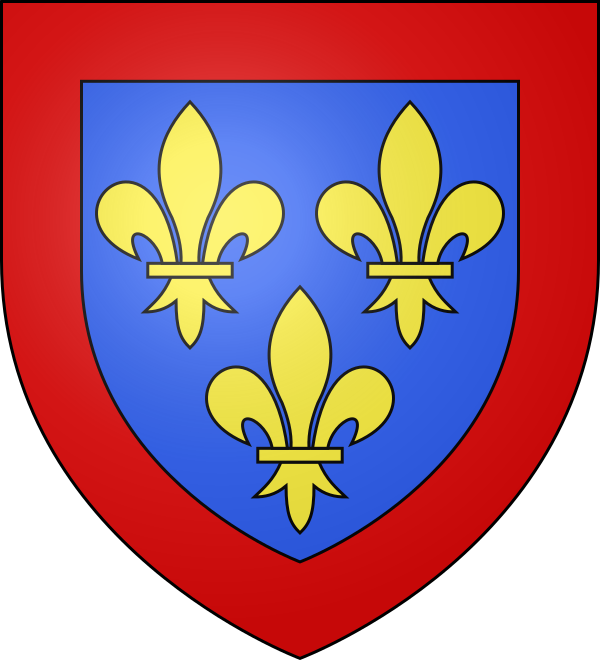Text from Wikipedia - the free encyclopaedia,
unless otherwise stated.
Royal Banner of England.
Based on Image:Flag of The Duchy of Lancaster.svg.
Date: 25 November 2009.
Author: Flag_of_the_Duchy_of_Lancaster.svg: Yaddah.
Derivative work: Brunanburh.
(Wikimedia Commons)

English: The Battle of Bouvines, won by King Philippe Auguste.
A 19th-Century depiction of King Philip II of France at The Battle of Bouvines.
Français:
Bataille de_Bouvines gagnee par Philippe Auguste.
Author: PHGCOM,
Horace Vernet
(1789-1863).
Date: Before 1863.
Source/Photographer:
Own work by uploader, photographed at Versailles. http://forum.artinvestment.ru/blog.php?b=273473&langid=5
(Wikimedia Commons)
The Battle of Bouvines, which took place on 27 July 1214, was a Mediaeval battle which ended
The 1202–1214 Anglo-French War. It was fundamental in the early development of
France in The Middle Ages by confirming The French Crown's Sovereignty over
Philip Augustus of France defeated an army, consisting of Imperial German, English,
and Flemish soldiers, led by Otto IV of Germany. Other leaders included Count Ferrand of Flanders, William de Longespee and Renaud of Boulogne. The defeat was so decisive that Otto was deposed and replaced by Frederick II Hohenstaufen; Ferrand and Renaud were captured and imprisoned
and King John of England was forced to agree to The Magna Carta by his discontented Barons. Philip was able to take undisputed control of most of the territories in France that had belonged
to King John of England, Otto's maternal uncle and ally.

The extent of The Angevin Empire around 1172.
Solid Yellow shows Angevin possessions.
Chequered Yellow shows Angevin hegemony.
Date: 2008.
Source: Own work.
Author: Cartedaos.
(Wikimedia Commons)
The Angevin Empire (French: L'Empire Plantagenêt) is, in modern usage, the collective term for the possessions of The Angevin Kings of England during the 12th- and 13th-Centuries.
The Angevins of The House of Plantagenet ruled over an area covering half of France, all of England, and parts of Ireland and Wales, and had further influence over much of the remaining British Isles. The Angevin Empire was established by King Henry II of England, as King of England, Count of Anjou, and Duke of Normandy. In 1152, through marriage to Eleanor of Aquitaine, he became Ruler of The Duchy of Aquitaine.
Despite the extent of Angevin Rule, Henry's son, King John, was defeated in The Anglo-French War (1202–1214) by King Philip II of France, of The House of Capet, following The Battle of Bouvines. John lost control of all his Continental possessions, apart from Gascony in Southern Aquitaine. This defeat set the scene for The Saintonge War and The Hundred Years' War.

France in 1154.
All the Red and Pink territory was in The Angevin Empire.
All the Blue territory was French.
Date: 15 December 2014.
Source:
Image:France 1154 Eng.jpg by Lotroo under copyleft.
france_1154_1184.jpg from the Historical Atlas by William R. Shepherd, 1911.
Author: Reigen.
(Wikimedia Commons)

English: Coat-of-Arms of Anjou.
Français: Blason du duché d'Anjou : d'azur au trois fleurs de lys d'or à la bordure de gueules.
Italiano: Stemma dei duchi di Angiò dopo la modernizzazione del XV secolo. D'azzurro con tre gigli d'oro e bordo rosso.
Date: 6 July 2007.
Source: Own work.
Author: Syryatsu.
(Wikimedia Commons)
Henry "Curtmantle", Count of Anjou, inherited The Kingdom of England on 25 October 1154, becoming King Henry II. The resulting Angevin Empire would, at its peak, spread from Ulster, Northern Ireland, to The Pyrenees. Henry's son, Richard I, had no legitimate issue upon his death, so, in 1199, Anjou passed to his nephew,Arthur of Brittany (the posthumous son of Henry II’s fourth son, Geoffrey), while The Crown of England passed to Henry II’s fifth son, and Richard’s youngest brother, John. Count Arthur was taken prisoner by his uncle the King in 1203 and disappeared under suspicious circumstances. In 1205, the County was seized by King Philip II Augustus of France. Its status was elevated to that of a Duchy for Prince Louis, the second son of King Jean II of France, and remained as such until The Revolution. Anjou corresponds largely to the present-day Department of Maine-et-Loire.

Carcassonne was a fortified City
in The County of Toulouse, next to Aquitaine and Gascony.
Date: 2 January 2002.
Author: Harry.
(Wikimedia Commons)
A brief look at The Angevins.
Available on YouTube at
France under King
Philippe Auguste.
Available on YouTube at


No comments:
Post a Comment